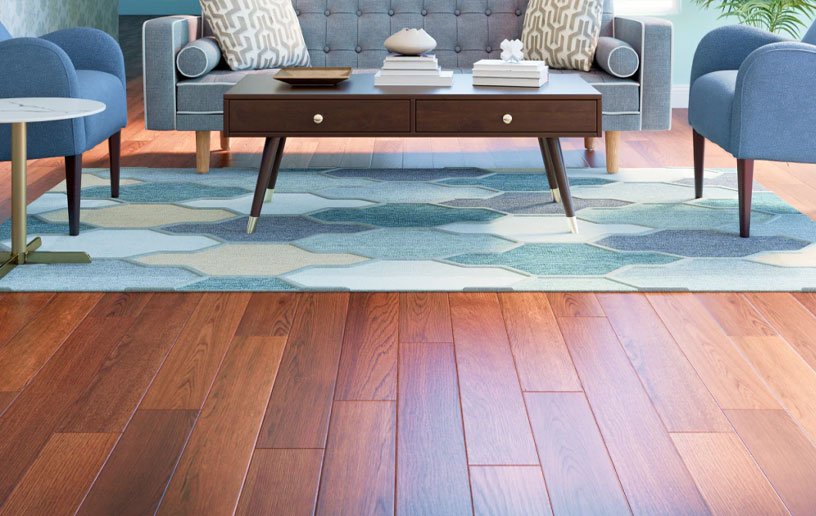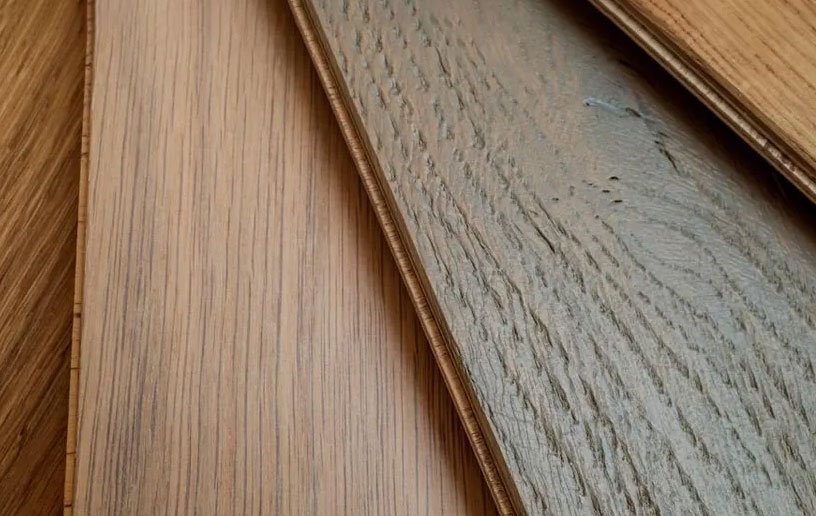Have you ever walked into a room and been immediately captivated by the warm, rich tones of a beautiful hardwood floor? Or have you admired the sleek, modern look of engineered wood planks? With so many flooring options available, it can be challenging to decide which one is best for your home.
Well, you’re in luck! Today, we’re going to dive into the world of hardwood and engineered wood flooring, exploring the pros and cons of each to help you make an informed decision.
Key Takeaways:
- Hardwood Flooring: Durable, aesthetically pleasing, and increases home value, but can be costly, tricky to install, and susceptible to moisture damage.
- Engineered Wood Flooring: Affordable, easy to install, and resistant to moisture, but has a shorter lifespan, limited refinishing options, and potential for delamination.
- Comparison: Hardwood is more expensive, durable, and has more refinishing options, while engineered wood is more budget-friendly, easier to install, and moisture-resistant.
- Choosing Between Hardwood and Engineered Wood: Depends on budget, preferences, and specific needs, such as moisture levels and subfloor conditions.
- Solid Wood Flooring: A third option, offering a longer lifespan and more refinishing options, but sharing the same downsides as hardwood.
- Types of Wood Flooring: Various wood types are available, including oak, maple, cherry, walnut, hickory, and bamboo, each with unique characteristics.
What is Hardwood Flooring?
Hardwood flooring is exactly what it sounds like – planks or strips made from solid, natural wood. These floors are crafted from various hardwood species, such as oak, maple, and cherry, each with its unique grain pattern and color. Hardwood floors are renowned for their durability, aesthetic appeal, and ability to increase the value of your home.
One of the biggest advantages of hardwood flooring is its longevity. With proper care and maintenance, these floors can last for decades, even centuries in some cases! They’re also incredibly beautiful, adding warmth and character to any space. Plus, let’s be real, who doesn’t love the rich, natural look of hardwood?
However, hardwood flooring does come with a few downsides. It can be quite costly, especially if you’re opting for high-end or exotic wood species. Installation can be a bit tricky too, requiring skilled professionals to ensure a seamless finish. And let’s not forget about moisture – hardwood floors are susceptible to warping and cracking if exposed to excessive moisture or humidity.
What is Engineered Wood Flooring?
Engineered wood flooring is a modern alternative to traditional hardwood. It’s constructed from layers of wood and plywood, with a top veneer made from real hardwood. This multi-layered design makes engineered wood floors more stable and resistant to moisture than solid hardwood planks.
One of the biggest advantages of engineered wood flooring is its affordability. It’s generally less expensive than hardwood, making it a budget-friendly option for those who want the look of natural wood without breaking the bank. Plus, it’s incredibly easy to install, often with a simple click-and-lock system that even DIY enthusiasts can tackle.
However, engineered wood floors do have some drawbacks. While they’re more resistant to moisture than solid hardwood, they’re not completely waterproof. And let’s not forget about lifespan – engineered wood floors typically have a shorter lifespan than solid hardwood, and refinishing options are limited.
Hardwood vs. Engineered Wood: A Comparison
Now that we’ve covered the basics, let’s dive into a side-by-side comparison of hardwood and engineered wood flooring:
| Characteristics | Hardwood Flooring | Engineered Wood Flooring |
|---|---|---|
| Cost | Generally more expensive | More affordable |
| Installation | Tricky, requires skilled professionals | Easier, faster, and DIY-friendly |
| Durability and Lifespan | Longer lifespan (decades to centuries) | Shorter lifespan (20-30 years) |
| Moisture Resistance | Susceptible to moisture damage | More resistant to moisture |
| Refinishing Options | Multiple refinishing options | Limited refinishing options |
| Appearance | Authentic, natural look and feel | Modern, sleek appearance |
| Maintenance | Requires regular maintenance | Easy to maintain |
| Subfloor Requirements | Specific subfloor requirements | More flexible subfloor requirements |
| Expansion and Contraction | More prone to expansion and contraction | Less prone to expansion and contraction |
Note: The table highlights the key differences between hardwood and engineered wood flooring, making it easier to compare and decide which option suits your needs.
Which is Better: Hardwood or Engineered Wood Flooring?
The answer to this question depends on your specific needs, preferences, and budget. Here are a few scenarios to help you decide:
Hardwood might be the better choice if:
- You have a higher budget and are willing to invest in a premium flooring option.
- You want a flooring material that can be refinished multiple times to maintain its appearance.
- You prefer the authentic look and feel of solid hardwood.
Engineered wood might be the better choice if:
- You’re working with a tighter budget and need a more cost-effective option.
- You’re installing floors in areas with higher moisture levels, like basements or bathrooms.
- You want a flooring material that’s easier and faster to install.
It’s important to consider factors like budget, subfloor condition, moisture levels in your home, and personal preferences when making your decision. And remember, consulting with a flooring professional can help ensure you make the best choice for your specific needs.
Engineered Wood vs. Solid Wood Flooring
While we’ve been comparing hardwood and engineered wood flooring, it’s worth noting that there’s another option: solid wood flooring. Solid wood floors, as the name suggests, are planks made entirely from a single piece of solid hardwood.
Like traditional hardwood flooring, solid wood floors offer a longer lifespan and more refinishing options than engineered wood. They’re also highly coveted for their ability to increase a home’s value. However, they share the same downsides as hardwood, such as higher costs and susceptibility to moisture damage.
When comparing engineered wood and solid wood flooring, engineered wood tends to be the more cost-effective and moisture-resistant option, while solid wood offers a longer lifespan and more refinishing opportunities.
Negatives of Engineered Wood Flooring
While engineered wood flooring has many advantages, it’s important to understand its potential drawbacks as well:
- Limited Lifespan: Compared to solid hardwood, engineered wood floors have a shorter lifespan, typically lasting 20-30 years with proper care.
- Potential for Delamination: If not installed correctly or exposed to excessive moisture, the layers of engineered wood can separate or delaminate over time.
- Susceptibility to Moisture Damage: While more moisture-resistant than solid hardwood, engineered wood floors can still be damaged by excessive moisture or humidity.
- Limited Refinishing Options: Due to the thin top veneer, engineered wood floors have limited options for refinishing, often needing to be replaced once the top layer is worn down.
Types of Wood Flooring
When it comes to both hardwood and engineered wood flooring, there are a variety of wood types to choose from, each with its unique characteristics:
Hardwood Flooring Types:

- White Oak: a classic choice that looks and feels natural and is high in decay resistance.
- Walnut: a popular choice in the US with a rich, brown color.
- American Cherry: a soft hardwood with a rich, red color.
- Hickory: one of the strongest wood species, with a light-brown color.
- Ash: a chic choice with a light white color.
- Maple: a popular choice for kitchens, with a distinctive grain pattern.
- Birch: an affordable option with above-average hardness.
- Mahogany: a dense and flexible option with a dark, warm color.
- Teak: a durable option with a high scratch resistance.
- Beech: a hard and durable option that is easy to cut and shape.
- Ebony: the hardest wood species, with a dark color.
- Brazilian Tigerwood: a safe bet for hardwood flooring, with a high hardness and density.
- Acacia: a sturdy and durable option that is resistant to scratches and dents.
- Bamboo: a strong and durable option with a low density.
- Alder: a soft hardwood that is easy to work with.
- Poplar: a soft hardwood with a yellow/brown color.
- Cypress: a coniferous tree with a high hardness rating.
- Eucalyptus: a hardwood with a considerable hardness rating and density.
- Cork: an unusual option that is strong against decay.
- American Chestnut: a hardwood with a high workability.
- Mesquite: a hardwood with a high resistance to water and decay.
- Merbau: an exotic hardwood with a trendy color pattern and texture.
Engineered Wood Flooring Types:

- Plywood: Versatile, strong, and durable, but hard to cut because of density.
- High-Density Fiberboard (HDF): Durable and resistant to moisture, but vulnerable to high heat.
- Particle Board: Cheap and lightweight, but not very durable.
- Blockboard: Lightweight, but hard to screw and nail together.
- Oriented Strand Board (OSB): Great for load-bearing applications, but swells when wet.
- Medium-Density Fiberboard (MDF): Strong and cheap, but absorbs water and swells.
- Cross-Laminated Timber (CLT): As strong as concrete, but difficult to run wires and pipes through.
- Click-Lock: Cost-effective, easy to install, and easy to remove.
- Nail-Down: This will deliver a perfect finish, but strenuous installation process.
- Adhesive: No creaking, very stable, but not easy to repair.
- High-pressure engineered wood: High resistance to water and chemicals, but high installation costs.
- Direct pressure-engineered wood: Not as costly as high-pressure engineered wood, but susceptible to tear and friction.
- Distressed Texture: Versatile, durable, low maintenance, but large carbon footprint.
- Wire Brushed: Conceals scratches and damage, but quick to collect dirt and grime.
- Hand Scraped: Looks authentic, and durable, but difficult to install.
- Glued Engineered Flooring: Costs cheaper than most other types of flooring, but is a pretty tedious job.
- Glueless Engineered Flooring: Easy to install, but pretty expensive.
- Click Lock Engineered Flooring: Very easy to install, but can be an expensive alternative.
- Pre-glued Engineered Flooring: Involved lesser hassles than glued engineered floors, but could be a time-consuming job.
When selecting a wood type, consider factors like durability, aesthetic appeal, and cost to find the perfect match for your home and lifestyle.
Conclusion
When it comes to hardwood vs. engineered wood flooring, there’s no one-size-fits-all answer. Both options have their unique advantages and drawbacks, and the best choice ultimately depends on your specific needs, budget, and preferences.
If you’re looking for a premium, long-lasting flooring option and have the budget to invest, hardwood floors might be the way to go. But if you need a more cost-effective and moisture-resistant solution, engineered wood could be the perfect fit.
Remember, to carefully evaluate your needs, consider factors like moisture levels and subfloor conditions, and don’t hesitate to consult with flooring professionals. With the right information and guidance, you’ll be able to make an informed decision and enjoy beautiful, durable floors in your home for years to come.




No Comment! Be the first one.